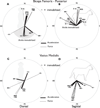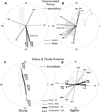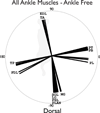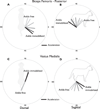Inter-joint coupling effects on muscle contributions to endpoint force and acceleration in a musculoskeletal model of the cat hindlimb
- PMID: 17640652
- PMCID: PMC4346316
- DOI: 10.1016/j.jbiomech.2007.06.001
Inter-joint coupling effects on muscle contributions to endpoint force and acceleration in a musculoskeletal model of the cat hindlimb
Abstract
The biomechanical principles underlying the organization of muscle activation patterns during standing balance are poorly understood. The goal of this study was to understand the influence of biomechanical inter-joint coupling on endpoint forces and accelerations induced by the activation of individual muscles during postural tasks. We calculated induced endpoint forces and accelerations of 31 muscles in a 7 degree-of-freedom, three-dimensional model of the cat hindlimb. To test the effects of inter-joint coupling, we systematically immobilized the joints (excluded kinematic degrees of freedom) and evaluated how the endpoint force and acceleration directions changed for each muscle in 7 different conditions. We hypothesized that altered inter-joint coupling due to joint immobilization of remote joints would substantially change the induced directions of endpoint force and acceleration of individual muscles. Our results show that for most muscles crossing the knee or the hip, joint immobilization altered the endpoint force or acceleration direction by more than 90 degrees in the dorsal and sagittal planes. Induced endpoint forces were typically consistent with behaviorally observed forces only when the ankle was immobilized. We then activated a proximal muscle simultaneous with an ankle torque of varying magnitude, which demonstrated that the resulting endpoint force or acceleration direction is modulated by the magnitude of the ankle torque. We argue that this simple manipulation can lend insight into the functional effects of co-activating muscles. We conclude that inter-joint coupling may be an essential biomechanical principle underlying the coordination of proximal and distal muscles to produce functional endpoint actions during motor tasks.
Figures






Similar articles
-
Role of biomechanics and muscle activation strategy in the production of endpoint force patterns in the cat hindlimb.J Biomech. 2007;40(16):3679-87. doi: 10.1016/j.jbiomech.2007.06.021. Epub 2007 Aug 10. J Biomech. 2007. PMID: 17692854
-
Functional muscle synergies constrain force production during postural tasks.J Biomech. 2008;41(2):299-306. doi: 10.1016/j.jbiomech.2007.09.012. Epub 2007 Nov 5. J Biomech. 2008. PMID: 17980370 Free PMC article.
-
Two functional muscle groupings during postural equilibrium tasks in standing cats.J Neurophysiol. 1996 Oct;76(4):2402-11. doi: 10.1152/jn.1996.76.4.2402. J Neurophysiol. 1996. PMID: 8899613
-
A biomechanical perspective on spinal mechanisms of coordinated muscular action: an architecture principle.Acta Anat (Basel). 1994;151(1):1-13. doi: 10.1159/000147637. Acta Anat (Basel). 1994. PMID: 7879588 Review.
-
Contributions to the understanding of gait control.Dan Med J. 2014 Apr;61(4):B4823. Dan Med J. 2014. PMID: 24814597 Review.
Cited by
-
Three-dimensional ankle moments and nonlinear summation of rat triceps surae muscles.PLoS One. 2014 Oct 31;9(10):e111595. doi: 10.1371/journal.pone.0111595. eCollection 2014. PLoS One. 2014. PMID: 25360524 Free PMC article.
-
Center of mass states render multijoint torques throughout standing balance recovery.J Neurophysiol. 2025 Jan 1;133(1):206-221. doi: 10.1152/jn.00367.2024. Epub 2024 Dec 10. J Neurophysiol. 2025. PMID: 39658948
-
Effects of kinematic complexity and number of muscles on musculoskeletal model robustness to muscle dysfunction.PLoS One. 2019 Jul 24;14(7):e0219779. doi: 10.1371/journal.pone.0219779. eCollection 2019. PLoS One. 2019. PMID: 31339917 Free PMC article.
-
Practical limits on muscle synergy identification by non-negative matrix factorization in systems with mechanical constraints.Med Biol Eng Comput. 2013 Feb;51(1-2):187-96. doi: 10.1007/s11517-012-0983-8. Epub 2012 Nov 3. Med Biol Eng Comput. 2013. PMID: 23124815 Free PMC article.
-
Directional constraint of endpoint force emerges from hindlimb anatomy.J Exp Biol. 2010 Jun 15;213(Pt 12):2131-41. doi: 10.1242/jeb.037879. J Exp Biol. 2010. PMID: 20511528 Free PMC article.
References
-
- Abelew TA, Huyghues-Despointes CMJI, Nichols TR. Three dimensional knee torques produced by the quadriceps and hamstrings muscles in the cat. 1996
-
- Anderson FC, Goldberg SR, Pandy MG, Delp SL. Contributions of muscle forces and toe-off kinematics to peak knee flexion during the swing phase of normal gait: an induced position analysis. Journal of Biomechanics. 2004;37(5):731–737. - PubMed
-
- Bernstein N. The Coordination and Regulation of Movements. New York: Pergamon Press; 1967.
-
- Biewener AA, Konieczynski DD, Baudinette RV. In vivo muscle force-length behavior during steady-speed hopping in tammar wallabies. J Exp Biol. 1998;201(Pt 11):1681–1694. - PubMed
-
- Bonasera SJ, Nichols TR. Mechanical actions of heterogenic reflexes among ankle stabilizers and their interactions with plantarflexors of the cat hindlimb. J Neurophysiol. 1996;75(5):2050–2070. - PubMed
Publication types
MeSH terms
Grants and funding
LinkOut - more resources
Full Text Sources
Medical
Miscellaneous

